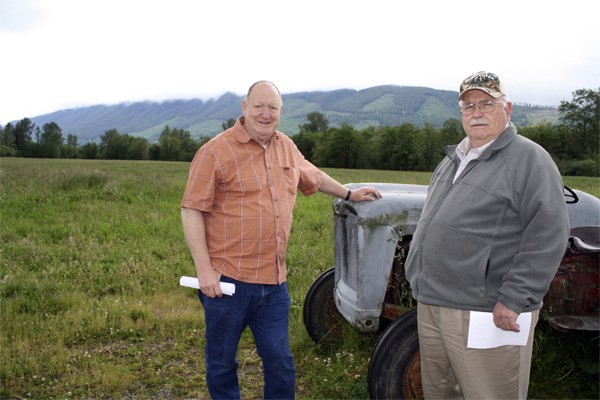Swallows dart overhead in the cool morning air as Jim Gildersleeve adjusts a spotting scope from his truck-cabin vantage point off Boalch Avenue. In the distance, his quarry stands up from the tall grass and looks around. There, Gildersleeve notes, catching a glimpse of a colored ear tag. That’s Peggy.
A cow elk tagged and radio-collared last summer in Meadowbrook’s central meadow, Peggy appears to be part of a small band along the treeline. Other elk are hidden in the treeline, invisible to sight but not to experience and other senses.
I can’t smell them, but Gildersleeve and fellow Upper Snoqualmie Valley Elk Management Group member and North Bend resident Harold Erland have more sensitive noses. They don’t need their equipment to know there are more elk hanging out this morning at Meadowbrook Farm—they can detect the musty scent of them.
“Their behavior is very unusual,” Gildersleeve said of the few visible, browsing animals. Peggy and her companions may be a nursery group—a handful of cows that watch over calves, idly searching out patches of clover while the rest of band feeds in peace.
“They’re social animals that way,” Erland explains.
Minutes later, he moves in for a closer look. The elk watch him cautiously, but don’t budge. That seems to prove that there are calves about, and that the elk aren’t afraid to defend them. Erland’s biggest fear is that some sightseer will unwittingly disturb them, and then face the business end of an angry mother cow: her deadly-sharp hooves.
“The elk are only doing what they’re supposed to do,” he said.
Clearer picture
Erland and Gildersleeve are putting together the clearest picture yet of the local elk population.
The Upper Valley Elk Management Group is in the second year of a five-year study, and results are already revealing something of the elk’s world.
Counts using spotters and radio and GPS collars put the total number of elk at about 430 animals. The elk population exploded several years ago, as the animals discovered plentiful food and safety on the Valley floor. But Erland believes the population is now flattening out, thanks to an annual controlled hunt and changing elk behavior.
Meadowbrook Farm is probably the best places to find elk in the Valley. In the spring, summer and fall, the vast acreage is a haven for the animals. But come winter, it’s an open question as to how many animals will stay.
Right now, forage is lush. That means healthy adults and calves.
“They are in very good condition,” Gildersleeve said. “Their hide is perfect.”
Elk in Meadowbrook come and go. One morning, spotters may find them in the big pastures there. The next, they may be at Mountain Meadows in North Bend, or on Indian Hill, or by the Snoqualmie River.
The management group now has GPS, or global positioning system, collars on four animals. In a presentation to Snoqualmie City Council earlier this month, Erland showed what the satellite found out about elk movements. On a color slide, the colored dots show animals roaming in distinct patterns, staking out sections of the Valley.
Erland was there to make a pitch for funding. He wants Snoqualmie to pay for two of three GPS collars tracking animals from Meadowbrook.
“I want them for this herd—to see exactly where they go,” Erland said.
The Meadowbrook elk herd appears to be shrinking, as hungry elk move into new winter ranges at Moon Valley, Ernie’s Grove and Mountain Meadows north of Snoqualmie and North Bend, then stay there.
“The people that live out in Moon Valley say they’ve never seen so many elk,” Erland said. At first, the elk are a welcome sight.
“They’re not going to start complaining until their gardens start disappearing,” he said, and “the fun part of having elk around is gone.”
Sense and safety
According to Erland, the Washington Department of Fish and Wildlife has had a single complaint from the Valley about elk this year.
The elk group’s mission is to help Valley residents learn about the animals, and become more tolerant.
“It’s not just a beautiful animal out in the field,” Gildersleeve said. “There are a lot of stakes in this.”
The city of North Bend, for example, wants elk information to help develop its new Tanner annex, while the city of Snoqualmie wants a census for a management plan. With a third of every accident involving elk resulting in human injury, the Washington Department of Transportation wants to understand where elk cross highways.
To these men, managing the animal requires respect for many interests, from tourism and public safety to the elk themselves.
“I think these elk are going to take care of themselves,” said Erland, who wants to see the herds back in highland meadows, where they belong.
“Meadowbrook has a lot of room, but there’s not enough for the elk that are there. They know that.”
The Valley floor and Meadowbrook will probably always be home to some animals.
“They need to have places to live, too,” Erland said.
“The elk are here to stay,” Gildersleeve said. “We have to live with them.”
“There has to be a balance,” Erland said. “We’re for the balance.”
• Learn more about the Upper Snoqualmie Valley Elk Management Group study and mission at snoqualmievalleyelk.org. The group next meets on Wednesday, July 13.


